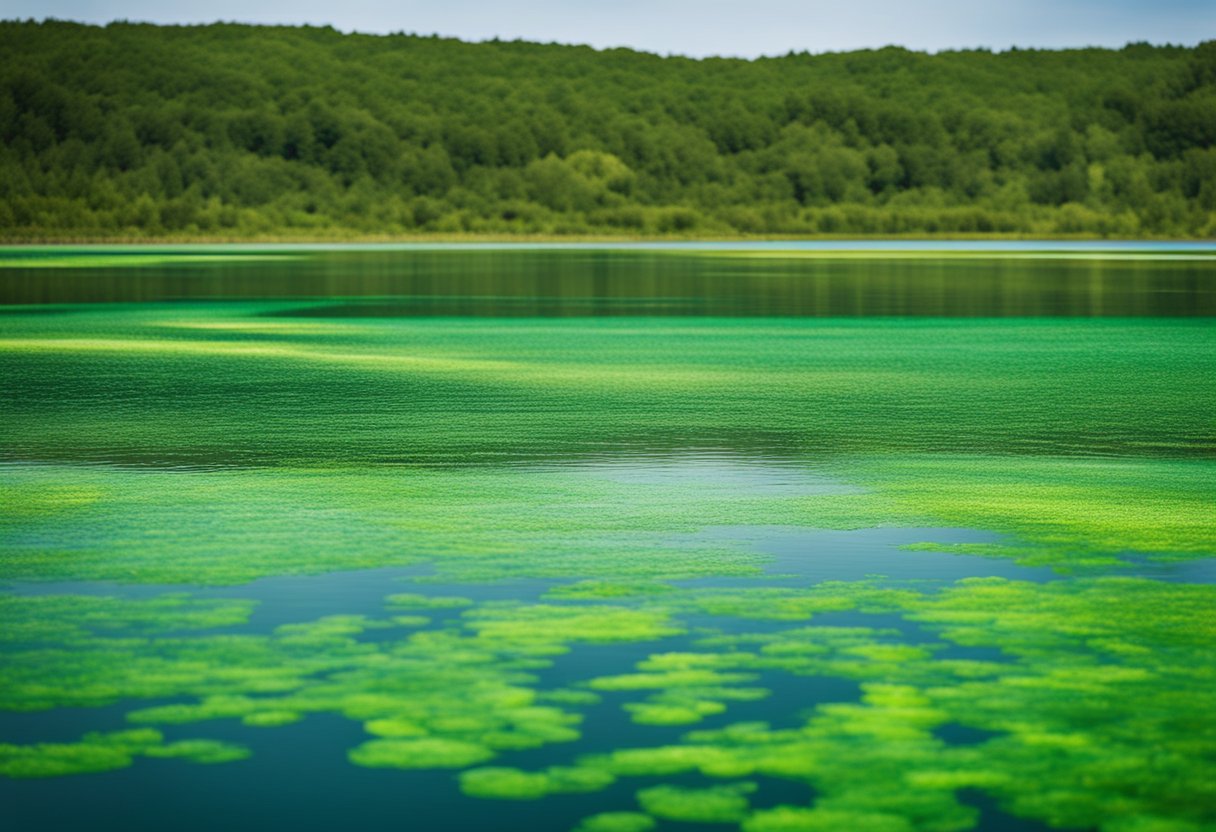Causes of harmful algal blooms: Understanding the factors behind the phenomenon
Harmful algal blooms, also known as HABs, occur when colonies of algae grow out of control in a body of water, producing toxins that can harm the environment, aquatic life, and human health. These events can cause damaging effects on ecosystems, economies, and public health. Several factors contribute to the formation of harmful algal blooms, such as nutrient pollution, water temperature, and changes in water flow.

An image captured of Keyser Pond on July 27, 2022, during a cyanobacteria outbreak. Image courtesy of Christine Bunyon.
Understanding the causes and underlying mechanisms of algal blooms is essential for effective monitoring, management, and mitigation of their impacts. Nutrient pollution stemming from agricultural runoff, wastewater discharge, and atmospheric deposition is a significant factor that facilitates algal growth. Additionally, climate change and increasing water temperatures enhance the growth of harmful algal species, making them more prevalent in certain areas.
Key Takeaways
- Algal blooms occur when algae grow rapidly, producing toxins that harm the environment, aquatic life, and human health.
- Causes for harmful algal blooms include nutrient pollution, rising water temperatures, and changes in water flow.
- Understanding the formation and factors contributing to harmful algal blooms is essential for monitoring, management, and mitigation of their impacts.
Understanding Algal Blooms

Algal blooms are a natural phenomenon that occur when populations of algae rapidly increase in water reservoirs. These blooms can occur in various environments, such as oceans, bays, and freshwater systems. Algal blooms can be harmless or harmful, depending on the species involved and the environmental factors that trigger them.
Harmful algal blooms (HABs) are typically caused by toxin-producing species, such as cyanobacteria or dinoflagellates. One of the most concerning types of harmful algal blooms is blue-green algae, which is actually a type of cyanobacteria. These organisms can produce harmful toxins, such as microcystin, cylindrospermopsin, and anatoxin. Exposure to these toxins can lead to various health issues in humans, as well as having adverse effects on marine mammals and birds.
Dinoflagellates are another group of organisms that can cause harmful algal blooms, such as red tides. These blooms are characterized by the release of toxins like saxitoxin, brevetoxin, ciguatoxins, and domoic acid. Some of these toxins can be lethal to marine life, while others can accumulate in fish and shellfish, posing a serious threat to human health.
In addition to the toxins produced during HABs, these events can negatively impact the environment by reducing oxygen levels in water, which leads to the formation of dead zones. Moreover, the dense growth of algae can form scum, mats, or foam on the water surface, making the environment aesthetically unpleasant and affecting aquatic life.
The occurrence and intensity of harmful algal blooms are influenced by a variety of factors, such as water temperature, nutrient availability, and weather conditions. For instance, excessive amounts of nutrients like phosphorus and nitrogen, typically found in agricultural runoff and sewage discharges, can stimulate the growth of both harmful and non-harmful algal species.
Understanding the ecology of harmful algal blooms and the factors that contribute to their development is crucial in developing effective strategies to prevent their occurrence and mitigate their impacts. Recent advances in research, monitoring, and management technologies have greatly improved our understanding of these phenomena, and further studies are being conducted to enhance our knowledge of HAB species, their impacts, and potential prevention methods.
Causes of Harmful Algal Blooms

Harmful algal blooms (HABs) occur when various factors come together and promote the rapid growth of certain algae species in water bodies. These overgrowths often result in negative impacts on aquatic ecosystems and pose threats to human health and the environment. The main causes of HABs include an excessive availability of nutrients, changing climate conditions, and human activities.
Nutrients: One of the primary causes of HABs is the excessive presence of nutrients like phosphorus and nitrogen in water bodies. These nutrients often come from agricultural and urban runoff, which can lead to eutrophication. Nutrient pollution fuels the exponential growth of harmful algal species, resulting in the formation of dense blooms.
-
Phosphorus: Fertilizers, manure, and sewage are the main sources of phosphorus, which is an integral component for the growth of harmful algal species.
-
Nitrogen: Nitrogen compounds, such as nitrate and ammonia, can also contribute to the growth of toxic algal blooms. They primarily originate from fertilizers, sewage, and atmospheric deposition.
Climate Change: The changing climate is another factor that contributes to the occurrence and severity of HABs. Rising temperatures, alterations in precipitation patterns, and increasing frequency of extreme weather events can all have significant effects on algal growth and distribution. Warmer waters may prolong the growing season of harmful algal species, while changes in precipitation can lead to nutrient-rich runoff entering water bodies.
Sunlight: Sunlight is essential for the growth of photosynthetic harmful algal species. Extended periods of strong sunlight can fuel the growth of HABs, especially when combined with other factors such as excessive nutrient availability and warm temperatures.
Human Activities: Human activities, including agriculture, industrial processes, and urban development, play a crucial role in the development of HABs by increasing nutrient pollution and altering the physical and chemical properties of water bodies. For example, land use changes, deforestation, and the construction of dams can all lead to the degradation of water quality and contribute to the occurrence of harmful algal blooms.
In conclusion, harmful algal blooms result from complex interactions between multiple factors, including nutrients, climate change, sunlight, and human activities. Efforts to control and mitigate the impacts of HABs should focus on addressing these underlying causes, with an emphasis on reducing nutrient pollution and preserving water quality.
Impacts and Monitoring of Harmful Algal Blooms

Harmful algal blooms (HABs) occur when algae grow excessively in water bodies, producing toxins that adversely affect the environment, animals, and humans. HABs can thrive in various aquatic environments, including freshwater, like lakes and rivers, brackish water, and salt water in coastal areas and marine environments. Some notorious US regions known for recurrent HAB occurrences include Alaska, California, Maine, and the Gulf of Mexico.
One of the significant impacts of HABs is the poisoning of shellfish and fish, which can lead to severe health effects when consumed by humans. In response to these dangers, the NOAA issues regular advisories to coastal communities to inform them of potential risks associated with seafood consumption. Furthermore, HABs can contaminate water supplies and reduce oxygen levels in the water, which can lead to massive fish kills, thereby disrupting ecosystems.
Monitoring HABs is of vital importance to protect public health, wildlife, and the economy. To effectively detect, monitor, and manage HABs, scientists conduct research and use various techniques and methods. Some of these methods include satellite imaging, water sampling, and even using drones to quickly identify the presence and extent of HAB events.
HABs have been observed in diverse locations, including:
- Louisiana and North Carolina - known for their rich marine life and seafood industry.
- Great Lakes region - critical for drinking water supplies and the largest group of freshwater bodies by area in the world.
- Alaska, California, and Maine - states that support critical fisheries and coastal tourism economies.
Despite ongoing efforts by numerous institutions, such as the Woods Hole Oceanographic Institution, HABs remain a significant challenge due to external factors like global warming and pollution. In addition, water temperatures and changes in the availability of nutrients in water bodies can influence the growth and spread of HABs.
As HABs present an ongoing threat to our environment, wildlife, and human health, continuous efforts in HAB monitoring and research remain crucial for mitigating their impact and safeguarding our ecosystems and communities.
Prevention and Future Research

Effective prevention and handling of harmful algal blooms (HABs) require a comprehensive understanding of the factors contributing to their formation and persistence. This includes the impact of climate change, which has been suggested to influence HAB occurrence1. Researchers are working on developing new tools for detecting, monitoring, and preventing HABs, adapting to future challenges posed by shifts in temperature and weather patterns.
One crucial aspect of addressing HABs is the development of accurate forecasting methods. These methods can help predict the severity and duration of HAB events, allowing for timely intervention and management efforts. As climate change continues to impact oceanic conditions, understanding how phenomena like hurricanes and other extreme weather events might influence HABs becomes increasingly important2.
In addition to monitoring the environmental factors associated with HABs, it is essential to study the toxins they produce, such as guanitoxin, azaspiracid, and dinophysistoxin3. Having a comprehensive understanding of these toxins and their effects on both ecosystems and human health is vital to developing effective mitigation strategies.
To further advance HAB prevention, several areas of future research should be prioritized:
- Developing more advanced monitoring systems to detect and predict the occurrence of HABs in real-time, thus enabling better prevention and management efforts4.
- Enhancing forecasting models, taking into account the various factors that may contribute to HAB formation, including the influence of climate change.
- Investigating toxin production and degradation by different algal species and their potential impacts on marine life and public health.
- Evaluating the efficacy of current HAB prevention and mitigation strategies, to inform the development of improved approaches.
Through focused and collaborative research efforts, it is possible to overcome the challenges associated with HABs and devise effective solutions to preserve both marine ecosystems and human well-being.
Footnotes
-
Harmful algal blooms and climate change: Learning from the past and present to forecast the future ?
-
Harmful algal blooms and their eco-environmental indication ?
-
Cyanobacterial harmful algal blooms: state of the science and research needs ?
-
Keeping tabs on HABs: new tools for detecting, monitoring, and preventing harmful algal blooms ?